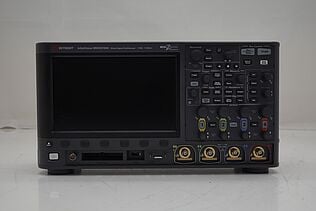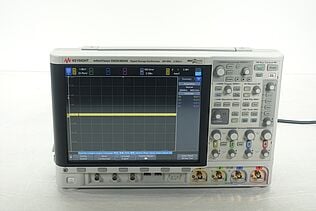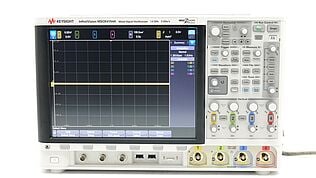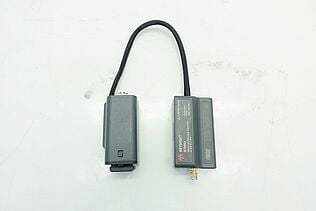- Introduction
- Types of Oscilloscopes – Analog and Digital
- Analog Oscilloscope Controls
- Calibrating An Analog Oscilloscope
- Is an Oscilloscope the Same as a Voltmeter?
- Oscilloscope vs. Multimeter
- Analog Oscilloscope Probes
- What is a Waveform?
- Waveform Capture Rate
- Horizontal and Vertical Deflection Plates
- Memory Depth
- X-Y Mode
- What Is Oscilloscope Overdrive?
- What is a protective input network?
- Devices Used with an Oscilloscope
- Popular Used Oscilloscopes
What is an Analog Oscilloscope?
Analog oscilloscopes are used to measure voltage against time in electrical instruments. They work by converting the voltage signal into a visual representation on a screen. Incoming voltage is displayed on the oscilloscope screen as a two-dimensional graph, with time running horizontally on the x-axis and voltage vertically on the y-axis. This makes it easy to see how the signal changes over time and helps to troubleshoot problems.
Buy Oscilloscopes at a Great Discount
Types of Oscilloscopes – Analog and Digital
Analog oscilloscopes (AKA CRO or Cathode-Ray Oscilloscope):
- Have a larger screen than digital oscilloscopes
- Are less expensive than digital oscilloscopes
- Typically have a slower response time than digital oscilloscopes
- Use a Cathode Ray Tube (CRT)* to display the signal
- Consist of vertical and horizontal channels, a trigger system, a time base, and a CRT module
- Cannot save data for later analysis
Digital oscilloscopes (AKA DSO or Digital Storage Oscilloscope):
- Typically provide a more accurate representation of the voltage signal
- Can save data for later analysis
- Can be connected to computers for data analysis
- Use a Liquid Crystal Display (LCD)
- Converts the original analog signal to a digital one using an analog-to-digital converter
To learn more about digital oscilloscopes and their uses, visit Oscilloscope Basics.
Analog oscilloscopes come with various acquisition modes, which determine the speed and resolution of the waveforms that are displayed. The most common modes are single-shot, repetitive or triggered, and streaming:
- Single-shot mode is the simplest mode, and it captures a single snapshot of the waveform.
- Repetitive or triggered mode is similar to single-shot mode, but it captures multiple waveform snapshots. This mode is useful for measuring repetitive signals, such as pulses or waveform patterns.
- Streaming mode captures the waveform over time, which allows you to see how it changes over time. This mode is useful for measuring transient signals, such as sharp voltage spikes.
| Control | Description & Effect |
|---|---|
| Vertical position control | The amplitude of the waveform (height of the wave) is controlled by the vertical position knob. The further the knob is turned to the right, the larger the amplitude. |
| Horizontal position control | The horizontal position control determines how far across the screen the waveform appears. The further to the left the knob is turned, the larger the time scale. |
| Horizontal sweep | The horizontal sweep is the speed at which the waveform moves across the screen. The knob should be turned until the waveform moves across the screen at a comfortable speed. |
| Focus control | The focus control adjusts the clarity of the waveform. The knob should be turned until the waveform is clearly visible. |
| Trigger control | The trigger control is used to set when the waveform should appear on the screen. There are auto and manual modes. |
| Timebase control | The timebase is the amount of time each division represents. This parameter together with the horizontal determine how fast the wave moves across the screen. The knob should be turned until the waveform moves across the screen at a comfortable speed. |
For more information about terms relating to your oscilloscope, visit our Oscilloscope Glossary.
Calibrating An Analog Oscilloscope
Calibrating an analog oscilloscope is a process of adjusting the settings on the scope so that it can accurately measure the voltage in a circuit. You can adjust several things, including the vertical and horizontal scales and the offset. It's important to calibrate an oscilloscope before you use it to be sure that it is giving accurate readings.
Is an Oscilloscope the Same as a Voltmeter?
An oscilloscope is not a voltmeter. A voltmeter measures voltage, while an oscilloscope measures voltage against time and is more suitable for different kinds of measurements.
Oscilloscope vs. Multimeter
A multimeter can measure the voltage and current in a circuit, while an oscilloscope can only measure the voltage. Oscilloscopes are used to help troubleshoot electrical problems, while multimeters are used to test for continuity, shorts, and grounds.
Analog Oscilloscope Probes
An analog oscilloscope probe is a device that is used to connect an oscilloscope to a circuit. It helps to amplify the signal so that it can be measured by the oscilloscope. Oscilloscope probes come in various sizes and shapes, depending on the type of oscilloscope. They are typically made from metal or plastic and have a number of pins or sockets that allow them to connect to the oscilloscope.
What is a Waveform?
A waveform is a complex, changing pattern of voltage or current over time. Repetitive waveforms of varying shapes are often encountered in electrical and electronic circuits. The most basic type of waveform is a square wave, which has a specific shape that repeats over and over. Square waves are often used in testing and calibration because they are easy to generate, and their shape is easy to measure.
Analog oscilloscopes use a CRT (cathode ray tube) to display a waveform pattern. The CRT is a large glass tube that contains two metal plates. When an electrical signal is applied to the plates, it creates an electron beam that travels across the tube. The beam is scanned from left to right, and the voltage at each point is measured. This information is then used to visualise waveform patterns on the screen.
A ramp waveform is a complex waveform that can be used to test circuits. It is created by combining two square waves of different frequencies. The ramp waveform can measure the frequency of a signal or diagnose problems with circuits.
Waveform Capture Rate
The waveform capture rate is the number of waveforms per second that the oscilloscope can capture. This is determined by the type of oscilloscope you are using, and it can vary from 10 waveforms per second to 100,000 waveforms per second. It's important to know the waveform capture rate when you are testing high-frequency circuits because it can affect the accuracy of your measurements.
Horizontal and Vertical Deflection Plates
Horizontal and vertical deflection plates are pairs of metal plates that are used to deflect the beam of electrons in the oscilloscope. This is helpful for circuits that are not producing a strong signal or for circuits being tested in high-frequency mode.
Memory Depth
The memory depth is the number of waveforms recorded in the oscilloscope's memory. This is determined by the type of oscilloscope you are using and the sample rate, and it can vary from 2 waveforms to 2 million waveforms. It's important to know the memory depth when you are testing high-frequency circuits because it can affect the accuracy of your measurements.
X-Y Mode
X-Y mode is a feature that allows you to plot two voltage signals against each other on the oscilloscope screen. This can help diagnose problems with circuits that have multiple signals. It's also helpful in measuring the frequency of a signal.
What Is Oscilloscope Overdrive?
Oscilloscope overdrive is a feature that allows you to boost the voltage signal so that it can be measured by the oscilloscope. This is helpful for circuits that are not producing a strong signal or for circuits being tested in high-frequency mode. Oscilloscope overdrive can be dangerous, so it should be used with caution.
What is a protective input network?
A protective input network is a feature that helps to protect the oscilloscope from damage. It is typically used when testing circuits with a high voltage or current. The input network absorbs the energy from the signal so that it doesn't damage the oscilloscope. It's important to use a protective input network when testing high-voltage or high-current circuits because it can help prevent damage to the scope.
Browse Oscilloscopes at a Great Discount
Select up to 3 instruments to compare
Enable Notifications
In order to use this feature, you need to enable notifications.
Manage notification preferences
Devices Used with an Oscilloscope
- Preamplifier- a device used to amplify the voltage signal before the oscilloscope measures it. This is helpful for circuits that are not producing a strong signal or for circuits that are being tested in high-frequency mode. Preamplifiers can be used with oscilloscope probes or with test leads. They come in various sizes and shapes, depending on the type of oscilloscope.
- Trigger generator- a device used to generate a specified trigger signal for the oscilloscope. It scans for a particular waveform and repeatedly overwrites it. This is helpful for circuits that are not producing a strong signal or for circuits that are being tested in high-frequency mode. The trigger generator can be used with oscilloscope probes or with test leads. It comes in various sizes and shapes, depending on the type of oscilloscope.
- Unblanking gate- a device used to blank the oscilloscope screen so that you can see the signal on the backlight. This is helpful for circuits that are not producing a strong signal or for circuits that are being tested in high-frequency mode. The unblanking gate can be used with oscilloscope probes or with test leads. It comes in a variety of sizes and shapes, depending on the type of oscilloscope.
As technology advances, Keysight's Used Equipment offers an ever-growing selection of digital oscilloscopes and other used test equipment to help you get the job done. Visit Keysight today to find the perfect piece of used equipment for your needs!
*A Cathode ray tube (CRT) is the type of screen used in analog oscilloscopes. It converts the voltage signal into a visual representation that is displayed on the screen. CRTs are no longer used in modern oscilloscopes, but they were once a common technology. Many DIYers still prefer to use analog oscilloscopes with a CRT screen, because the image is easier to see than on a digital screen.

Subscribe to Get Our Latest News, Updates, and Articles.
Popular Used Oscilloscopes
Keysight Used Oscilloscopes offers a wide range of industry leading pre-owened oscilloscopes, ranging from older generation Agilent oscilloscopes to the newest Keysight oscilloscope models. So whether you are a fist time buyer, replacing a model like-for-like or looking for upgrade – we have something for you.





































































